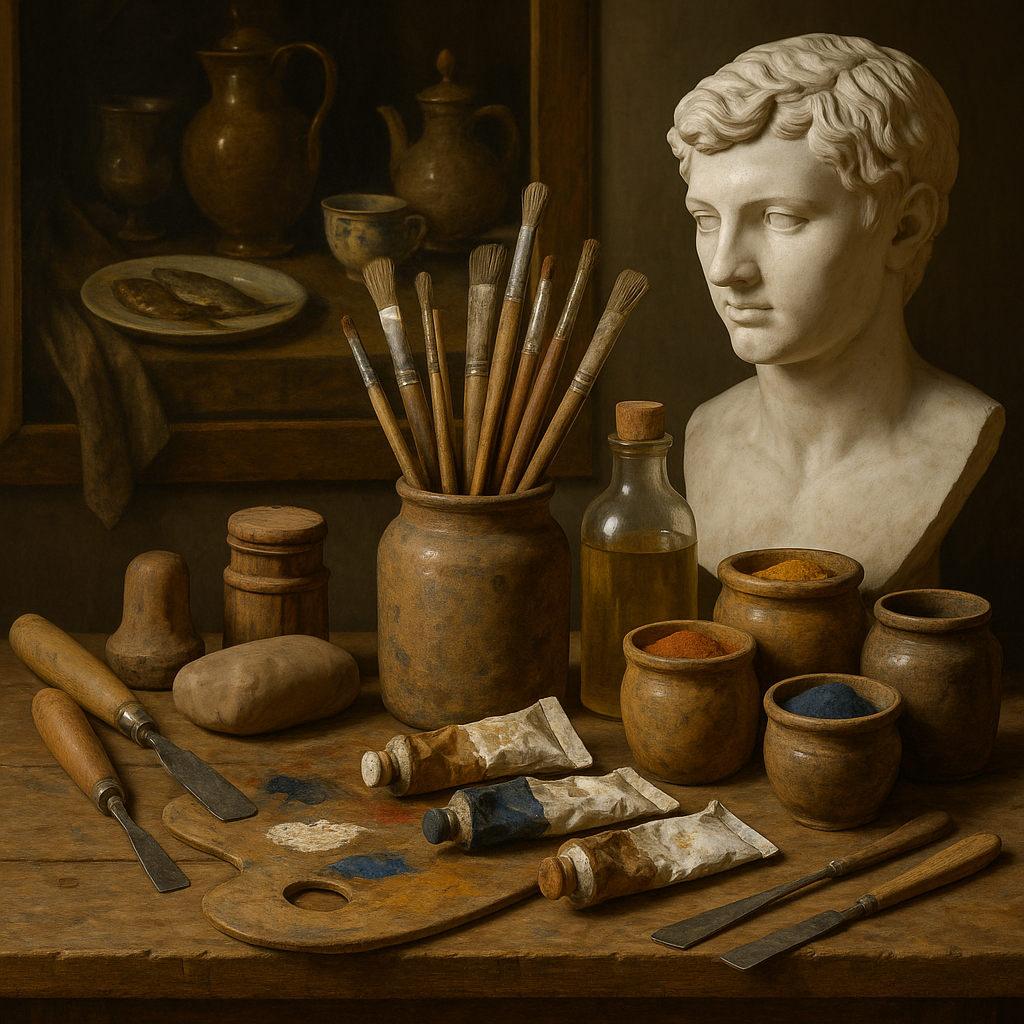
Técnicas y materiales del arte holandés
Explorando la artesanía de los maestros holandeses, incluida la escultura.

1. Pintura al óleo: el medio dominante de la Edad de Oro holandesa
Durante el Siglo de Oro neerlandés, la pintura al óleo se convirtió en el medio esencial para capturar la vitalidad de la vida cotidiana, la sutileza de la luz y la grandeza de la historia. Artistas como Rembrandt, Vermeer y Frans Hals dominaron la técnica, combinando pigmentos con óleos para crear colores profundos, texturas realistas y efectos brillantes. La flexibilidad de la pintura al óleo permitió obtener detalles finos y contrastes dramáticos, convirtiéndola en la herramienta perfecta para el realismo y la innovación que definieron el arte neerlandés del siglo XVII.

2. Pinceladas: Precisión y textura en la pintura
La pincelada utilizada en el arte holandés abarcaba desde trazos audaces hasta detalles delicados, y esto era clave para lograr el realismo y la textura que hicieron del arte holandés algo tan distintivo. Pinceladas sueltas: Se utilizaban para crear movimiento y fluidez, especialmente en pinturas de paisajes y escenas con agua. Pinceladas apretadas: Se utilizaban en la pintura de bodegones para capturar detalles minuciosos de la textura, especialmente el reflejo en el vidrio, el metal y la porcelana. Empaste: Una capa gruesa de pintura aplicada para crear textura, a menudo utilizada en el retrato por artistas como Rembrandt para enfatizar la profundidad y la emoción.

3. Escultura: dominio de la forma y el espacio
La escultura en los Países Bajos tiene una rica historia, especialmente durante el Renacimiento y el Barroco, donde los escultores holandeses demostraron una excepcional destreza en bronce, mármol, madera y piedra. A diferencia de sus homólogos italianos, los escultores holandeses solían preferir representaciones más realistas de sus temas, incluyendo retratos, figuras religiosas y escenas mitológicas. Escultores y técnicas clave: Artus Quellinus (1609-1668): Uno de los escultores barrocos más importantes, conocido por sus detalladas esculturas de mármol y bronce. Su obra se caracteriza por composiciones dinámicas y una gran sensación de movimiento. Adriaen de Vries (1545-1626): Escultor manierista, famoso por sus detalladas estatuas de bronce y complejas escenas mitológicas, que fusionan los estilos clásico y barroco. Jan Pieterszoon Coen: Conocido por sus esculturas monumentales encargadas por las Indias Orientales Neerlandesas.

4. Técnicas de naturaleza muerta: simbolismo y detalle
La pintura holandesa de naturalezas muertas, o "ontbijt" (piezas de desayuno), se convirtió en un género propio durante el Siglo de Oro, capturando objetos cotidianos con intrincado detalle y a menudo incorporando significados simbólicos. Vanitas: Los artistas solían incluir símbolos de la fugacidad de la vida, como calaveras, flores marchitas y relojes de arena, transmitiendo temas de memento mori que recordaban al espectador la impermanencia de la vida.

5. Acuarela y gouache: ligereza y precisión
Si bien la pintura al óleo era predominante, la acuarela y el gouache eran medios importantes para capturar la delicadeza de la naturaleza, especialmente en estudios y bocetos botánicos. Artistas como Aelbert Cuyp emplearon estos medios para crear paisajes suaves y atmosféricos.

6. Materiales y técnicas modernas
Los artistas holandeses continuaron evolucionando sus métodos en el siglo XX, adoptando nuevos materiales y técnicas como parte de movimientos como De Stijl y el expresionismo abstracto. Pinturas acrílicas: Ofrecieron a los artistas mayor flexibilidad, secado rápido y colores más vibrantes en comparación con los óleos. Materiales industriales: Los artistas de la era moderna solían incorporar objetos encontrados, acero, plástico y vidrio en sus obras, lo que contribuyó al auge de la escultura moderna.

7. Técnicas de escultura contemporánea
En la escultura holandesa contemporánea, los artistas han adoptado el arte conceptual y de instalación, a menudo centrándose en el proceso de creación en lugar del producto terminado. Escultores holandeses como Theo Jansen (conocido por sus esculturas cinéticas llamadas Strandbeests) han explorado el movimiento mecánico y las formas biomecánicas, fusionando el arte con la ingeniería. Características clave: Arte cinético: Muchos escultores holandeses modernos integran el movimiento en sus esculturas, creando obras dinámicas que interactúan con su entorno y los espectadores. Técnicas mixtas: Los escultores contemporáneos son conocidos por usar materiales no tradicionales como plástico, caucho y materiales reciclados para crear esculturas que invitan a la reflexión, a menudo conscientes del medio ambiente. Materiales: Acero, alambre y PVC: Estos materiales se utilizan comúnmente en la escultura cinética, creando obras que se mueven con el viento o con propulsión mecánica. Resina y fibra de vidrio: Estos materiales permiten la creación de esculturas a gran escala que son a la vez duraderas y ligeras.
Conclusión Técnicas del arte holandés
La tradición artística neerlandesa se define por su diversidad de técnicas y materiales, desde el minucioso detalle de la pintura al óleo hasta el realismo y el simbolismo de los bodegones, pasando por las dinámicas esculturas del Barroco. La evolución de las técnicas escultóricas, desde el mármol y el bronce hasta las modernas esculturas cinéticas y de técnica mixta, pone de manifiesto el compromiso del país con la innovación y la artesanía artística. Los artistas neerlandeses siempre han trascendido los límites de su arte, ya sea capturando el más mínimo detalle o reimaginando la relación del arte con el espacio y el movimiento. El legado del arte neerlandés, incluida la escultura, sigue resonando entre los espectadores de todo el mundo, celebrando tanto la tradición como la experimentación contemporánea.
Esta versión ampliada incorpora una mirada integral a las técnicas de escultura holandesa junto con otros métodos artísticos, garantizando que el medio esté bien representado junto con la rica tradición de la pintura en la historia del arte holandés.
